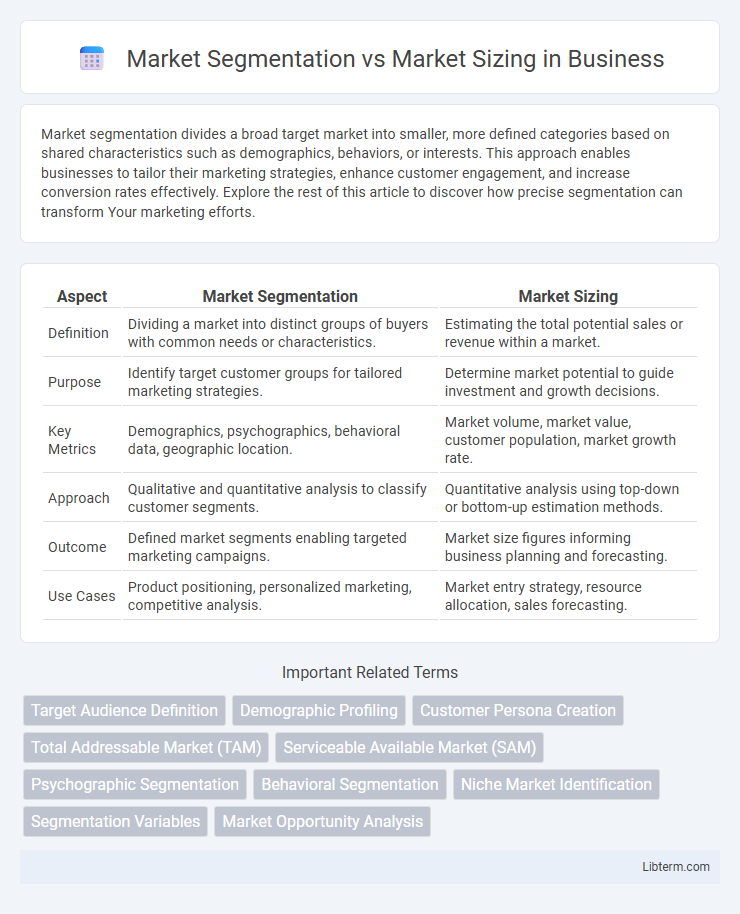Market segmentation divides a broad target market into smaller, more defined categories based on shared characteristics such as demographics, behaviors, or interests. This approach enables businesses to tailor their marketing strategies, enhance customer engagement, and increase conversion rates effectively. Explore the rest of this article to discover how precise segmentation can transform Your marketing efforts.
Table of Comparison
| Aspect | Market Segmentation | Market Sizing |
|---|---|---|
| Definition | Dividing a market into distinct groups of buyers with common needs or characteristics. | Estimating the total potential sales or revenue within a market. |
| Purpose | Identify target customer groups for tailored marketing strategies. | Determine market potential to guide investment and growth decisions. |
| Key Metrics | Demographics, psychographics, behavioral data, geographic location. | Market volume, market value, customer population, market growth rate. |
| Approach | Qualitative and quantitative analysis to classify customer segments. | Quantitative analysis using top-down or bottom-up estimation methods. |
| Outcome | Defined market segments enabling targeted marketing campaigns. | Market size figures informing business planning and forecasting. |
| Use Cases | Product positioning, personalized marketing, competitive analysis. | Market entry strategy, resource allocation, sales forecasting. |
Introduction to Market Segmentation and Market Sizing
Market segmentation divides a broad consumer or business market into sub-groups based on shared characteristics such as demographics, behaviors, or needs, enabling targeted marketing strategies. Market sizing estimates the total potential sales or revenue within a specific market, providing a quantitative foundation for investment and resource allocation decisions. Both concepts are essential for strategic planning, with segmentation focusing on market structure and sizing addressing market potential.
Defining Market Segmentation: Purpose and Methods
Market segmentation involves dividing a broad consumer or business market into sub-groups based on shared characteristics such as demographics, psychographics, geographic location, or behavior patterns, enabling targeted marketing strategies. The primary purpose of market segmentation is to identify distinct customer needs and preferences, allowing businesses to tailor products, services, and messaging for increased relevance and competitive advantage. Common methods for defining market segments include cluster analysis, surveys, and behavioral data analysis, which help in accurately profiling segments and predicting their responsiveness to marketing efforts.
Understanding Market Sizing: Scope and Approaches
Market sizing involves quantifying the potential demand for a product or service within a defined target market, providing businesses with actionable data on market opportunity. It employs top-down, bottom-up, and value-theory approaches to estimate market volume, revenue potential, or customer base size across geographic, demographic, or behavioral segments. Accurate market sizing supports strategic planning, resource allocation, and investment decisions by identifying the scope and scale of market opportunities.
Key Differences Between Market Segmentation and Market Sizing
Market segmentation involves dividing a broad target market into smaller, distinct groups based on shared characteristics such as demographics, behavior, or needs, allowing for tailored marketing strategies. Market sizing estimates the total potential sales or revenue opportunity within a specific market or segment, often quantified in terms of volume or value. The key difference lies in segmentation's role in identifying and understanding diverse customer groups, while sizing focuses on quantifying market potential for decision-making and resource allocation.
Why Market Segmentation Matters in Business Strategy
Market segmentation enhances business strategy by identifying distinct customer groups based on demographics, behaviors, and preferences, enabling more targeted marketing efforts and personalized product offerings. This precise focus improves resource allocation, maximizes customer engagement, and drives higher conversion rates compared to broad market approaches. Understanding specific segments also uncovers niche opportunities and competitive advantages, crucial for sustainable growth and increased profitability.
The Importance of Accurate Market Sizing
Accurate market sizing provides critical data for resource allocation, helping businesses prioritize segments with the highest revenue potential. It quantifies the total addressable market (TAM), enabling precise forecasting and investment decisions. Without reliable market sizing, even well-defined market segmentation strategies risk misdirection and ineffective marketing efforts.
Tools and Techniques for Effective Market Segmentation
Effective market segmentation employs tools like cluster analysis, factor analysis, and decision trees to categorize consumers into distinct groups based on demographics, psychographics, and behavioral data. Techniques such as RFM (Recency, Frequency, Monetary) analysis and customer persona development enhance targeting precision by identifying high-value segments and tailoring marketing strategies. Integration of AI-driven analytics platforms accelerates data processing and uncovers hidden patterns, optimizing segmentation accuracy and resource allocation compared to traditional market sizing methods.
Best Practices for Calculating Market Size
Market sizing requires a clear definition of the target market and segmentation based on demographics, behavior, and needs to ensure accuracy. Use a combination of top-down approaches like industry reports and bottom-up methods such as customer data analysis to validate estimates. Employ triangulation of multiple data sources and regularly update assumptions to reflect market dynamics and improve precision.
Integrating Market Segmentation with Market Sizing for Growth
Integrating market segmentation with market sizing enables businesses to identify high-potential customer groups and accurately estimate their revenue contributions, optimizing resource allocation for growth. Detailed segmentation criteria such as demographics, psychographics, and purchasing behavior refine the market sizing process, ensuring precise targeting and effective market entry strategies. This synergy provides actionable insights that drive strategic planning, product development, and scalable expansion efforts.
Common Pitfalls to Avoid in Segmentation and Sizing Analysis
Common pitfalls in market segmentation include over-segmentation, leading to overly narrow target groups that hinder effective marketing strategies, and reliance on superficial data without deep customer insights. In market sizing, errors often arise from inflated assumptions and inadequate consideration of market dynamics, resulting in unrealistic revenue forecasts. Avoiding these mistakes requires precise data validation, clear definition of segment criteria, and alignment of sizing models with real-world market behavior.
Market Segmentation Infographic

 libterm.com
libterm.com